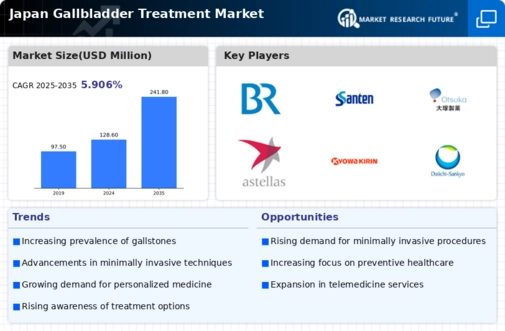Increased Healthcare Expenditure
Japan's healthcare expenditure has been steadily increasing, which positively impacts the gallbladder treatment market. With the government investing more in healthcare services, patients have better access to diagnostic and treatment options for gallbladder disorders. In 2025, healthcare spending is projected to reach approximately ¥42 trillion, reflecting a commitment to improving health outcomes. This financial support enables hospitals and clinics to adopt advanced technologies and provide comprehensive care for gallbladder conditions. Consequently, as healthcare resources expand, the gallbladder treatment market is expected to benefit from enhanced service availability and improved patient access to necessary treatments.
Advancements in Surgical Techniques
Innovations in surgical techniques, particularly minimally invasive procedures, are significantly influencing the gallbladder treatment market. Techniques such as laparoscopic cholecystectomy have gained popularity due to their reduced recovery times and lower complication rates. In Japan, the adoption of these advanced surgical methods has been on the rise, with studies showing that laparoscopic procedures account for over 80% of gallbladder surgeries. This shift not only enhances patient outcomes but also encourages more individuals to seek surgical intervention for gallbladder issues. As surgical technology continues to evolve, the gallbladder treatment market is likely to experience sustained growth driven by these advancements.
Growing Awareness of Gallbladder Health
Public awareness campaigns focusing on gallbladder health are becoming increasingly prevalent in Japan. These initiatives aim to educate the population about the risks associated with gallbladder disorders and the importance of early detection and treatment. As awareness grows, more individuals are likely to seek medical advice and treatment for gallbladder issues, thereby driving demand in the gallbladder treatment market. Additionally, healthcare professionals are emphasizing preventive measures, which may lead to earlier interventions and better health outcomes. This heightened awareness is expected to contribute to the overall growth of the market as more patients engage with healthcare services.
Rising Incidence of Gallbladder Disorders
The increasing prevalence of gallbladder disorders in Japan is a primary driver for the gallbladder treatment market. Factors such as dietary habits, obesity, and sedentary lifestyles contribute to the rise in conditions like gallstones and cholecystitis. Recent statistics indicate that approximately 10-15% of the Japanese population may develop gallstones at some point in their lives. This growing incidence necessitates effective treatment options, thereby expanding the market. Furthermore, as awareness of gallbladder health increases, more individuals seek medical intervention, which further propels the demand for treatment solutions. Thus, the gallbladder treatment market is positioned for growth as healthcare providers adapt to the rising number of cases and develop targeted therapies.
Aging Population and Associated Health Issues
Japan's aging population is a significant driver of the gallbladder treatment market. As individuals age, the likelihood of developing gallbladder disorders increases, leading to a higher demand for treatment options. By 2025, it is estimated that over 30% of the Japanese population will be aged 65 and older, a demographic that is particularly susceptible to gallbladder diseases. This demographic shift necessitates a robust healthcare response, including specialized treatments for gallbladder conditions. Consequently, the gallbladder treatment market is poised for growth as healthcare providers adapt to the needs of an aging population, ensuring that effective treatment options are available.





















Leave a Comment